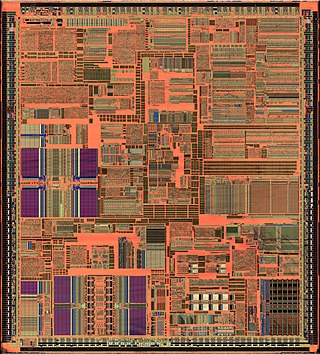
Intel Corporation is an American multinational corporation and technology company headquartered in Santa Clara, California. It is the world's largest semiconductor chip manufacturer by revenue, and is one of the developers of the x86 series of instruction sets, the instruction sets found in most personal computers (PCs). Incorporated in Delaware, Intel ranked No. 45 in the 2020 Fortune 500 list of the largest United States corporations by total revenue for nearly a decade, from 2007 to 2016 fiscal years.

A microprocessor is a computer processor where the data processing logic and control is included on a single integrated circuit, or a small number of integrated circuits. The microprocessor contains the arithmetic, logic, and control circuitry required to perform the functions of a computer's central processing unit. The integrated circuit is capable of interpreting and executing program instructions and performing arithmetic operations. The microprocessor is a multipurpose, clock-driven, register-based, digital integrated circuit that accepts binary data as input, processes it according to instructions stored in its memory, and provides results as output. Microprocessors contain both combinational logic and sequential digital logic, and operate on numbers and symbols represented in the binary number system.

The Pentium is a fifth generation, 32-bit x86 microprocessor that was introduced by Intel on March 22, 1993, as the very first CPU in the Pentium brand. It was instruction set compatible with the 80486 but was a new and very different microarchitecture design from previous iterations. The P5 Pentium was the first superscalar x86 microarchitecture and the world's first superscalar microprocessor to be in mass production—meaning it generally executes at least 2 instructions per clock mainly because of a design-first dual integer pipeline design previously thought impossible to implement on a CISC microarchitecture. Additional features include a faster floating-point unit, wider data bus, separate code and data caches, and many other techniques and features to enhance performance and support security, encryption, and multiprocessing, for workstations and servers when compared to the next best previous industry standard processor implementation before it, the Intel 80486.

Cyrix Corporation was a microprocessor developer that was founded in 1988 in Richardson, Texas, as a specialist supplier of floating point units for 286 and 386 microprocessors. The company was founded by Tom Brightman and Jerry Rogers.

The Pentium II brand refers to Intel's sixth-generation microarchitecture ("P6") and x86-compatible microprocessors introduced on May 7, 1997. Containing 7.5 million transistors, the Pentium II featured an improved version of the first P6-generation core of the Pentium Pro, which contained 5.5 million transistors. However, its L2 cache subsystem was a downgrade when compared to the Pentium Pros. It is a single-core microprocessor.

The Pentium Pro is a sixth-generation x86 microprocessor developed and manufactured by Intel and introduced on November 1, 1995. It introduced the P6 microarchitecture and was originally intended to replace the original Pentium in a full range of applications. While the Pentium and Pentium MMX had 3.1 and 4.5 million transistors, respectively, the Pentium Pro contained 5.5 million transistors. Later, it was reduced to a more narrow role as a server and high-end desktop processor and was used in supercomputers like ASCI Red, the first computer to reach the trillion floating point operations per second (teraFLOPS) performance mark. The Pentium Pro was capable of both dual- and quad-processor configurations. It only came in one form factor, the relatively large rectangular Socket 8. The Pentium Pro was succeeded by the Pentium II Xeon in 1998.
The PR system was a figure of merit developed by AMD, Cyrix, IBM Microelectronics and SGS-Thomson in the mid-1990s as a method of comparing their x86 processors to those of rival Intel. The idea was to consider instructions per cycle (IPC) in addition to the clock speed, so that the processors become comparable with Intel's Pentium that had a higher clock speed with overall lower IPC.

In personal computer microprocessor architecture, a back-side bus (BSB), or backside bus, was a computer bus used on early Intel platforms to connect the CPU to CPU cache memory, usually off-die L2. If a design utilizes it along with a front-side bus (FSB), it is said to use a dual-bus architecture, or in Intel's terminology Dual Independent Bus (DIB) architecture. The back-side bus architecture evolved when newer processors like the second-generation Pentium III began to incorporate on-die L2 cache, which at the time was advertised as Advanced Transfer Cache, but Intel continued to refer to the Dual Independent Bus till the end of Pentium III.
Slot 2 refers to the physical and electrical specification for the 330-lead Single Edge Contact Cartridge used by Intel's Pentium II Xeon and Pentium III Xeon.

Intel Architecture Labs (IAL) was the personal-computer system research-and-development arm of Intel during the 1990s.

The P6 microarchitecture is the sixth-generation Intel x86 microarchitecture, implemented by the Pentium Pro microprocessor that was introduced in November 1995. It is frequently referred to as i686. It was succeeded by the NetBurst microarchitecture in 2000, but eventually revived in the Pentium M line of microprocessors. The successor to the Pentium M variant of the P6 microarchitecture is the Core microarchitecture which in turn is also derived from P6.
The transistor count is the number of transistors in an electronic device. It is the most common measure of integrated circuit complexity. The rate at which MOS transistor counts have increased generally follows Moore's law, which observed that the transistor count doubles approximately every two years. However, being directly proportional to the area of a chip, transistor count doesn't represent how advanced corresponding manufacturing technology is, which is better characterized by transistor density instead.

Pentium is a series of x86 architecture-compatible microprocessors produced by Intel. The original Pentium was first released on March 22, 1993.

The history of general-purpose CPUs is a continuation of the earlier history of computing hardware.

The Swanson School of Engineering is the engineering school of the University of Pittsburgh in Pittsburgh, Pennsylvania. Founded in 1846, the Swanson School of Engineering is the second or third oldest in the United States.

Avtar Saini is a microprocessor designer and developer. He holds some patents related to microprocessor design. He is also former director for Intel's South Asia division. He is best known for his leadership role in the design and development of Pentium processor at Intel.

ServerWorks Corporation was an American fabless semiconductor company based in Santa Clara, California, that manufactured chipsets for server computers and workstations running IA-32 microprocessors. Founded as Reliance Computer Corporation in 1994, it filed its initial public offering in the beginning of 2000 and was acquired by Broadcom for nearly US$1 billion.

Vladimir Mstislavovich Pentkovski was a Soviet-American computer scientist, a graduate of the Moscow Institute of Physics and Technology and winner of the highest former Soviet Union's USSR State Prize (1987). He was one of the leading architects of the Soviet Elbrus supercomputers and the high-level programming language El-76. At the beginning of 1990s, he immigrated to the United States where he worked at Intel and led the team that developed the architecture for the Pentium III processor. According to a popular legend, Pentium processors were named after Vladimir Pentkovski.














